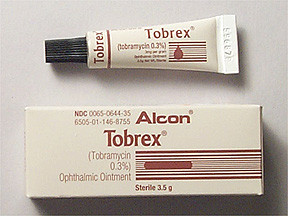TOBRAMYCIN OINTMENT - OPHTHALMIC
PHONETIC PRONUNCIATION: (TOE-bra-MYE-sin)
COMMON BRAND NAME(S): Tobrex
GENERIC NAME(S): tobramycin
Uses
USES: This medication is used to treat eye infections. Tobramycin belongs to a class of drugs called aminoglycoside antibiotics. It works by stopping the growth of bacteria. This medication treats only bacterial eye infections. It will not work for other types of eye infections. Unnecessary use or overuse of any antibiotic can lead to its decreased effectiveness.
How to use TOBRAMYCIN OINTMENT - OPHTHALMIC
HOW TO USE: Do not wear contact lenses while you are using this medicine. Sterilize contact lenses according to manufacturer's directions and check with your doctor before using them. Apply eye ointment to the affected eye(s) as follows: Wash hands first. To avoid contamination, be careful not to touch the tube tip or let it touch your eye. Tilt your head back, look upward and pull down your lower eyelid to make a pouch. Place a 1/2 inch (1.3 centimeters) strip of ointment into the pouch by squeezing the tube gently. Look downward and gently close your eyes for 1 to 2 minutes. Roll your eyeball in all directions to spread the medication. Try not to blink and do not rub your eye. Repeat these steps for your other eye if so directed. Apply as often as directed by your doctor. Wipe the tip of the ointment tube with a clean tissue to remove excess medication before recapping it. If you are using another kind of eye medication (e.g., drops or other ointments), wait at least 5 to 10 minutes before applying other medications. Use eye drops before eye ointments to allow the eye drops to enter the eye. Use this medication regularly in order to get the most benefit from it. Remember to use it at the same times each day. Continue to use this medication for the full time prescribed even if symptoms disappear after a few days. Stopping the medication too early may allow bacteria to continue to grow, which may result in a relapse of the infection. Inform your doctor if your condition persists or worsens.
Side Effects
Precautions
Interactions
Overdose
Images
Reviews
Faq for TOBRAMYCIN OINTMENT - OPHTHALMIC
Tobramycin ointment is an ophthalmic medication that contains the active ingredient tobramycin. It is commonly used to treat bacterial eye infections.
Tobramycin ointment works by killing or inhibiting the growth of bacteria that cause eye infections. It belongs to the class of medications known as aminoglycoside antibiotics.
Tobramycin ointment is effective in treating bacterial conjunctivitis (pink eye) and other bacterial eye infections.
Tobramycin ointment should be applied to the affected eye(s) as directed by your doctor. It is typically recommended to apply a thin strip of ointment inside the lower eyelid 2 to 3 times per day. Avoid touching the tip of the ointment tube to any surface to prevent contamination.
Common side effects of Tobramycin ointment include blurred vision, stinging or burning sensation, itching, redness, and temporary eye discomfort. If you experience severe allergic reactions or any other unusual symptoms, seek medical attention immediately.
Yes, Tobramycin ointment is generally safe for use in children as prescribed by a healthcare professional. However, it is important to consult a doctor before administering any medication to children.
It is generally recommended to avoid wearing contact lenses while using Tobramycin ointment. The ointment may contain ingredients that can build up on contact lenses and cause discomfort or damage.
The duration of treatment with Tobramycin ointment can vary depending on the severity of the infection. It is important to complete the full course of treatment as prescribed by your doctor, even if symptoms improve before that.
It is advisable to consult a healthcare professional before using Tobramycin ointment during pregnancy or while breastfeeding to assess any potential risks.
Disclaimer
IMPORTANT: HOW TO USE THIS INFORMATION: This is a summary and does NOT have all possible information about this product. This information does not assure that this product is safe, effective, or appropriate for you. This information is not individual medical advice and does not substitute for the advice of your health care professional. Always ask your health care professional for complete information about this product and your specific health needs.

No Reviews Yet